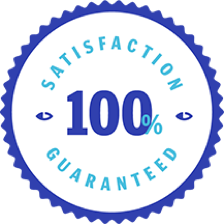About The Test
-
Do online eye tests actually work?
Short answer, Yes! Our online eye test has been clinically proven to produce prescriptions as accurate as prescriptions provided by traditional eye tests. See Clinical Trial Summary Report.
For added peace of mind, we use board-certified ophthalmologists, in your state, to conduct all examinations and issue all prescriptions based on their independent clinical judgment.
-
What are the basics I need to know about taking eyeTest.com's at home eye test?
First: our at-home eye test is as easy on your wallet as it is on your time.
In under 10 minutes, eyeTest.com can replicate the same type of atmosphere and conditions as a brick-and-mortar doctor's office making it incredibly convenient to take our eye test from the comfort of your own home. And by using our easy-to-understand written and audio instructions, you'll be guided through our eye test, which will have you look at and respond to the same types of ophthalmological pictures as you would in an outside-your-house ophthalmologist's office.
The eye test itself has you use your computer screen (which will display carefully calibrated images for you to respond to) as well as your smartphone (which will record your answers to the test's questions). Based on your responses, one of eyeTest.com's board-certified ophthalmologists will review and issue (if relevant) the perfect prescription to help correct your eyes (or, he or she will offer other medical guidance).
-
I don't need a webcam?
Nope: No webcam is needed to take our at-home eye test.
You *will* need a desktop or laptop computer; a smartphone; the fastest Internet connection you can access (preferably broadband); and enough space so you can walk about 10 feet away from your computer screen to read what's on it.
-
How much time should I set aside for my eye test?
The actual test only takes about 5 minutes, start to finish, but if you want to account for getting into the right space, adjusting the lighting and making sure you have enough room to walk away from your computer to read the screen, you might tack on another 10-15 minutes. It's up to you and how "ready" your room is.
-
Can I take my eye test by myself, or do I need another person with me?
eyeTest.com has designed its at-home eye test so that anyone can take it on their own, without needing someone else there. (Though if you want a friend there, fine by us. Everything's better with a friend.)
-
Can kids take an eyeTest.com at-home eye test?
No. The approved age range is 22-55.
-
Outside of kids, can anyone take the online eye test?
Anyone within our age bracket of 22-55 may take our eye test; however, eyeTest.com can't offer our prescription services to folks who don't meet our other criteria namely, our health requirements.
Here are the guidelines for who can be eyeTest.com patients. They must...
- Be between 22-55 years of age
- Have no history of amblyopia, diabetes, hypertension, glaucoma, cataracts, retinal detachment, brain injuries, or other neurological issues
- Be without recent discomfort or symptoms of acute eye pain, flashes and/or floaters
- Have a prescription range that is...
- Emmetropic
- Myopic (i.e., nearsighted) with a spherical power between -0.25 and -10.
- Hyperopic (i.e., farsighted) with a spherical power between +.25 and +3.55
- Astigmatic, with cylinder power between Cyl -0.25 and -3.0
- Presbyopic, with ADD power between +0.25 and +4.0
-
I've heard that some people try to cheat on eye tests. Why would someone do that?
Some folks cheat because they need a clean bill of eye health to apply to a police academy or flight school, or to get their driver's license. We're sure there are other reasons, but those are just a few.
-
Is it possible to cheat on an eyeTest.com eye test?
eyeTest.com's at-home eye test is hard to cheat because we've designed our algorithms to be able to tell when someone's answers to our questions (or to the screens) are all over the place.
We remind patients that the only right answer is their most honest one, and that it does them a huge disservice to "fib."
Now: In typical refractive eye tests, if folks really wanted to cheat, all they'd have to do is memorize the eye chart. But when you take eyeTest.com's eye test, people can't memorize a chart for three reasons: our questions are asked randomly; we use pattern recognition software; and we have a double verification system which prevents cheating even further.
-
Can I use eyeTest.com if I don't have a pre-existing prescription?
Most patients looking for an updated prescription need to give eyeTest.com a previous prescription so our ophthalmologists can better understand your vision history. Doing so sets us up with the best possible chance of giving you the most accurate prescription possible.
Now: For patients who have never had an eye test and have only a mild script, eyeTest.com doesn't require a previous script except if you're looking for a prescription for contacts. (The reason? Newbie lens wearers have to have an in-person lens fitting with an eye care professional.)
If your goal is to get contacts (and you've never taken a eye test), we can help. Contact one of our incredibly friendly customer service reps at service@eyeTest.com and we'll do all we can to find you a board-certified ophthalmologist in your neck of the woods.
-
Clinical Trial Summary Report
C. Thomas Dow, M.D.1
Objective. This study was undertaken to determine if a self-directed, computer-based response to presented stimuli (Opternative exam) can generate a refractive outcome that approximates the results of a manifest refraction as determined by experienced eye care professionals (Manifest exam).
Method. The results from sixty eyes of thirty consecutive subjects meeting inclusion/exclusion criteria2 who successfully completed the Opternative exam were analyzed for comparison to the refractive results of a Manifest exam in a double blind fashion. Subjects were given trial frames at the completion of both exams in order to evaluate their vision in both an objective (LogMAR acuity) and subjective fashion (survey quesionnaire). The questionnaire contained a 10 point visual satisfaction ranking question, where 0 was blind and 10 was perfect vision. The questionnaire also contained a confidence based question to determine how confident the subjects were after wearing the respective prescriptions. The 10 point confidence questionnaire had a rating scale of 0 being not confident, and 10 being extremely confident.
Results. Visual satisfaction rating, as determined by survey, measured symmetrically high for both tests. The Opternative exam received an average visual satisfaction rating of 8.633 out of 10 (with 10 being the best vision), while the Manifest exam received an average visual satisfaction rating of 8.917. In addition, the Opternative exam received an average confidence rating of 8.700 out of 10 (with 10 being the most confident), while the Manifest exam received an average confidence rating of 8.967. 42/60 (70%) eyes had a spherical equivalent difference of 0.25 diopter or less; while 54/60 (90%) eyes had a spherical equivalent difference of 0.55 diopter or less. Best corrected visual acuity average measurements determined with trial frame lenses from both of the two refractive modalities produced results better than 20/20: 20/15.9 LogMAR (Opternative); 20/14.9 LogMAR (Manifest). Spherical equivalence (SE) correlation was found to be very high, with an r value of 0.925, and 88% of the prescriptions were within 0.55D of one another.
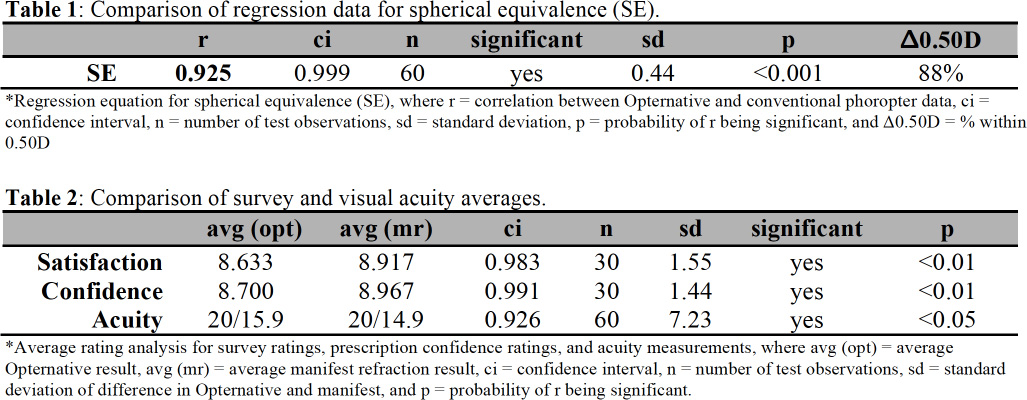
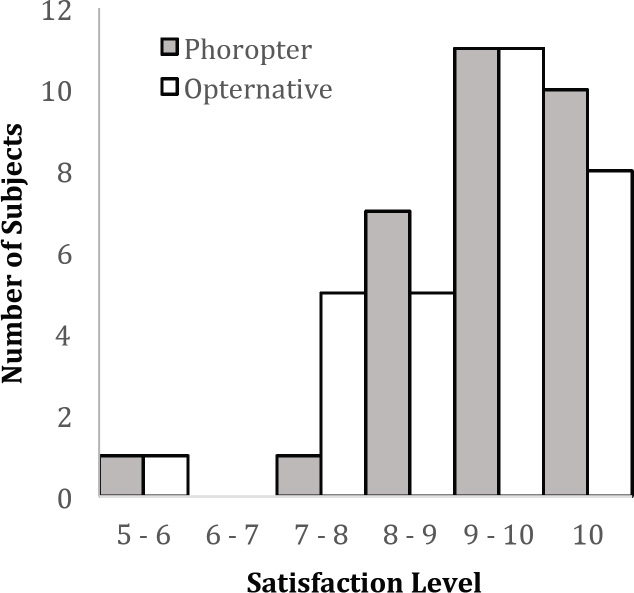
Figure 1: Visual satisfaction ratings from the Opternative exam and conventional phoropter based exam.
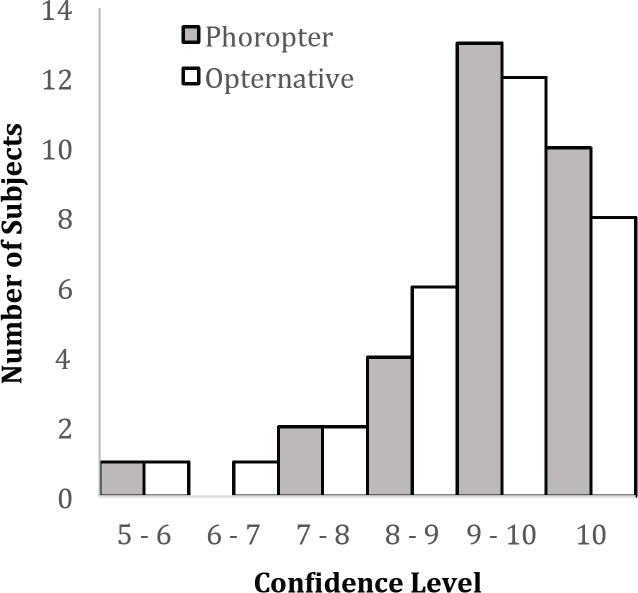
Figure 2: Subject confidence ratings from the Opternative exam and conventional phoropter based exam.
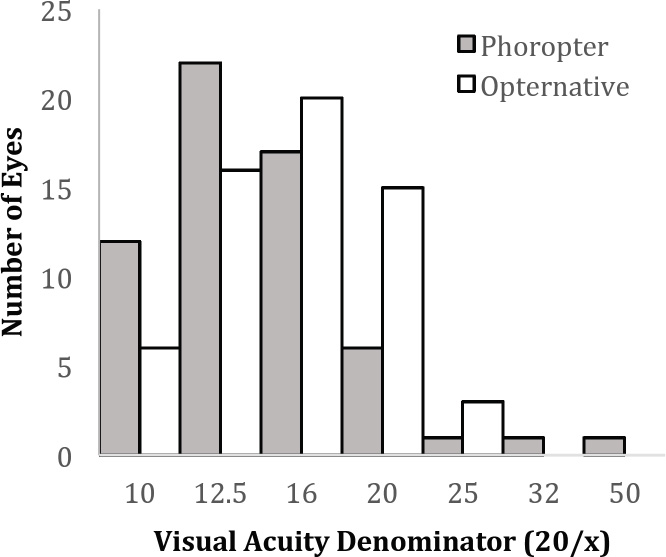
Figure 3: Visual acuity LogMAR results from subjects who took the Opternative exam and conventional phoropter based exam.
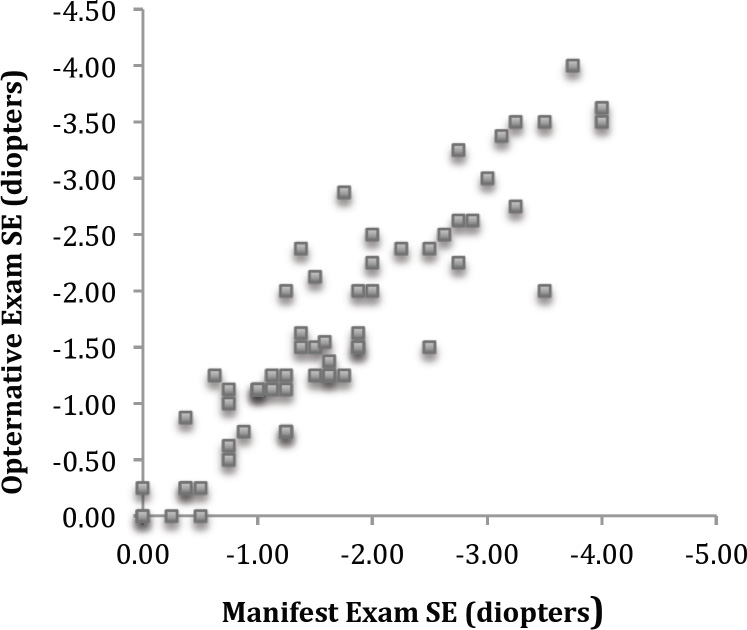
Figure 4: Correlation between Opternative exam SE and conventional phoropter based exam SE.
Discussion. The preliminary evaluation of the Opternative digital refraction system shows strong refractive correlation with the traditional manifest exam. In accordance with the study protocols the Opternative digital exam was placed purposely at a disadvantage, generating prescriptions from scratch, versus the Manifest exam that had assistance from prior prescriptions. The exam not only shows a high visual acuity outcome from prescriptions generated from the Opternative examination, but also high confidence level from patients receiving an Opternative prescription; moreover, survey shows the Opternative exam to provide a satisfactory interactive experience.
1 Chippewa Valley Eye Clinic, Eau Claire, Wisconsin and McPherson Eye Research Institute, Madison, Wisconsin.
2 18-40 year olds with no ocular or systemic disease, myopia up to -4.00, astigmatism up to -2.00 -
What if I have to stop the test while in the middle of it?
You can restart from the beginning of the eye test at any time. If you need to stop, simply exit your browser and come back whenever you are ready to take your test. There will be link on your order detail page and your order confirmation email. Simply click on the link to resume your test.
Get In Touch
